Golden Tree Snake
These Golden Tree Snake are also known as Flying Snakes or Gliding Snakes. They glide very well, perhaps the best of any snake in the world, and even better than some squirrels and lizards.
Golden Tree Snakes are lime green (งูเขียว) and black checkered type patterned snake. They are tree dwellers but can climb anything, even walls. They appear to have a favorite food – the Tokay Geckos that reach sizes of 12+ inches long in adulthood. They are frequently seen eating Tokays.
Thailand Snakes – Venomous and Non-Venomous snake information!
Chrysopelea ornata (Golden Tree Snake)
Thai language: Ngoo kee-ow ly dok mak
Appearance: Chrysopelea ornata in Thailand is lime or pale green with some black and green crosshatches. This snake’s head is rather flat with a thin neck and atypical blunt nose, large eyes which sometimes are red depending on the angle. Generally seen as a green snake (งูเขียว) while moving.
The head is adorned with bands, dots in a row, and wavy lines of yellow on a black background.
The underbelly (ventral) surface is light green or yellow without pattern.
Similar Looking Snakes: The king cobra as a juvenile can look very much like C. ornata.

Length: Up to 140 cm (almost 5 feet). They only get about as thick as 2-3 fingers held together.
Range: All over Thailand and many countries in Southeast Asia.
Habitat: Golden Tree Snakes can be found just about anywhere – in an apartment in Bangkok, or climbing bushes at 500 meters vertical elevation. Typically I see them at sea-level crossing the roads, or laying flat out along the stem of a low-lying palm tree branch.
They can climb up trees with smooth bark, concrete walls, and even the corners of walls in your home.
Notes: If you’re trying to catch one of these snakes it can be very difficult. They are excellent escape artists and once they get into a clump of bushes or up a tree – forget it. Go look for something else, you won’t catch it. They can disappear in trees so fast it’s hard to believe. Occasionally, you can find these in caves – they eat bats too.
I usually see them perched in a palm tree on the bough. I also often see them crossing the road very quickly. They move so fast that they sometimes appear to hover there and not move very much. If there is any grip to the road surface, they can go very quickly.
Active Time? Diurnal – daytime.
Food: Small geckos, lizards, large Tokay geckos, rodents, bird eggs, insects, another snake occasionally, and bats. Golden Tree Snakes kill by squeezing the neck of their prey, crushing it and stopping breathing.
Natural Enemies: Mongoose, rat snakes, cat snakes, monitor lizards will eat these snakes when they can catch them. When they are small, birds eat them.
Defensive Behavior: Golden Tree Snakes (flying snakes) bite quickly when played with. As adults, they may not lose that temperament. As babies – I have one now for some photos and video, most of them lose it quickly – and are OK with being held. They are very fast snakes when escaping.
Venom Toxicity: Rear fanged mildly venomous snake – but the venom is not known to be dangerous to humans. Just the same, don’t let it bite down on you more than a second or two before you remove it.
There have been no confirmed cases of medically significant envenomation with Golden Tree Snakes.
Offspring: Little is known about the breeding habits of these snakes because it is difficult to get them to mate while captive. Being oviparous it lays 6-12 eggs in May-June and they hatch in June. Baby snakes are 11-15cm long (4-6″)
Golden Tree Snake Identification Photo
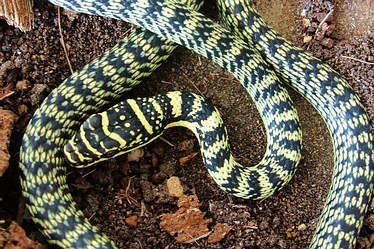
Kingdom: Animalia
Phylum: Chordata
Class: Reptilia
Order: Squamata
Suborder: Serpentes
Family: Colubridae
Subfamily: Colubrinae
Genus: Chrysopelea
Species: C. ornata
Binomial name: Chrysopelea ornata
Discovered, classified by Shaw, 1802
Video: My Baby Golden Tree Snake in Thailand:
#งูเขียว #greensnake

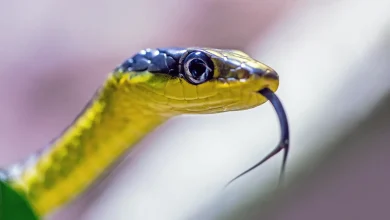
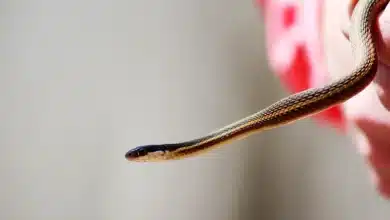
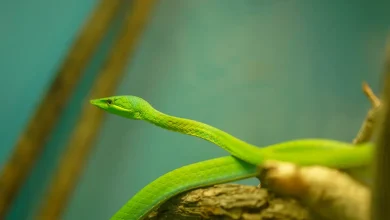
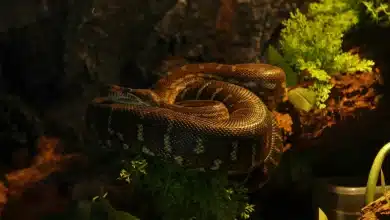
Are you sure it’s not potentially dangerous? Because i have the exact snake in our balcony. Im so scard! It trespassed our property
I am as sure as I can get. Sounds like you’re not sure! If it’s that snake, yeah, harmless for people. Assuming you’re not allergic to the venom.
Hi Mr Vern,
I found an injured gravid female and it laid 4 good eggs and 2 bad eggs on 25th March, and the female died a week after laying the eggs, how long does it takes for them to hatch? Should I cut the eggs lies on some videos on YouTube or let them hatch themselves ?
Thanks,
like on some YouTube videos*
Hi Samuel, I read your other comment already – it was C. paradisi! Nice snake. Don’t ever cut the eggs. Cheers!
I have what I believe to be one of these that likes to hang around outside my house. I know the venom is not proven to be dangerous for humans, but what about babies/toddlers? Thanks for your help and the fantastic site!
I want to say “no effect” – but I have no idea. Probably no effects.
It HATCHED!!! N I just realized it’s a paradise tree snake
nice…
Just wondering if the book has all snakes listed. You have 75ish listed here. I have been up all night and counted 3 times and got 3 different numbers. I broke them down into different categories. Anyway. I am doing this for a volunteer teaching project I am working on. I teach 2nd and 3rd graders about foreign countries. I have only done African & South American countries and Mexico but now I am working on Asian countries. I have collected 1000’s of pictures from National Geographic going back 40 or more years I bought 2 copies of each magazine and laminated them so I could put them up so the kids could see the people in their homes, see the animals, see the countryside see everything that National Geographic photographed (within reason of course). We also try some of the food. I learn some of the crafts. I am now finding music and fairy tales online. I will be contacting embassy’s to see if they will look over the list of foods and animals that I have for their countries to see if they are correct and complete and to see if they will send me a good map of the country. and maybe a small desk flag. If I have not found a craft from that country that the kids can do yet then I will also ask them for a suggestion. Thanks for your website
I’m not aware of any book that has all the snakes of Thailand listed. Sounds like a massive project you’re on there! Best of luck man…